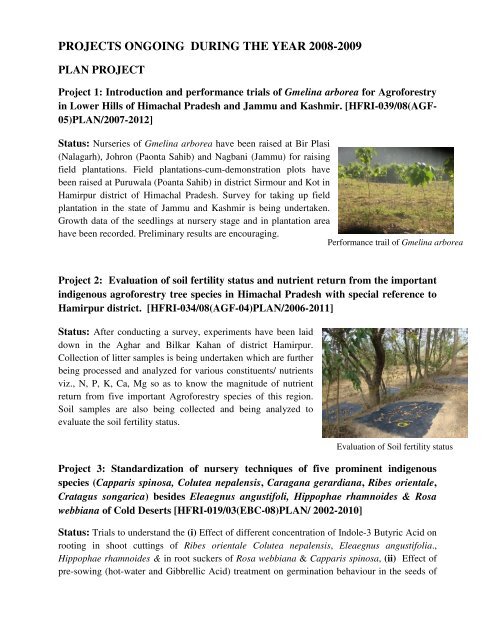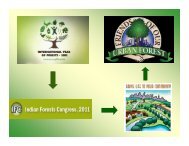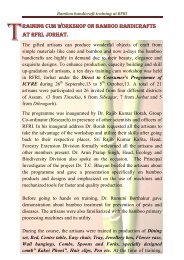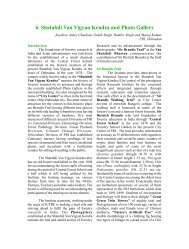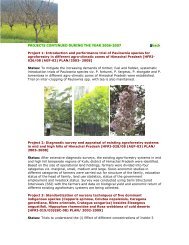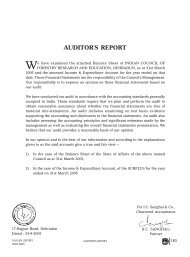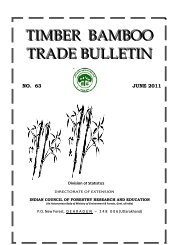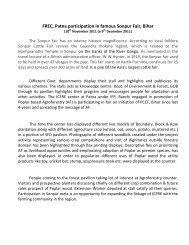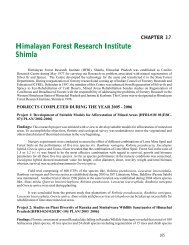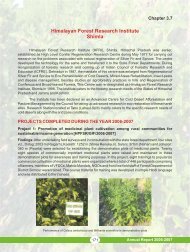PROJECTS ONGOING DURING THE YEAR 2008-2009 - ICFRE
PROJECTS ONGOING DURING THE YEAR 2008-2009 - ICFRE
PROJECTS ONGOING DURING THE YEAR 2008-2009 - ICFRE
You also want an ePaper? Increase the reach of your titles
YUMPU automatically turns print PDFs into web optimized ePapers that Google loves.
<strong>PROJECTS</strong> <strong>ONGOING</strong> <strong>DURING</strong> <strong>THE</strong> <strong>YEAR</strong> <strong>2008</strong>-<strong>2009</strong><br />
PLAN PROJECT<br />
Project 1: Introduction and performance trials of Gmelina arborea for Agroforestry<br />
in Lower Hills of Himachal Pradesh and Jammu and Kashmir. [HFRI-039/08(AGF-<br />
05)PLAN/2007-2012]<br />
Status: Nurseries of Gmelina arborea have been raised at Bir Plasi<br />
(Nalagarh), Johron (Paonta Sahib) and Nagbani (Jammu) for raising<br />
field plantations. Field plantations-cum-demonstration plots have<br />
been raised at Puruwala (Poanta Sahib) in district Sirmour and Kot in<br />
Hamirpur district of Himachal Pradesh. Survey for taking up field<br />
plantation in the state of Jammu and Kashmir is being undertaken.<br />
Growth data of the seedlings at nursery stage and in plantation area<br />
have been recorded. Preliminary results are encouraging.<br />
Performance trail of Gmelina arborea<br />
Project 2: Evaluation of soil fertility status and nutrient return from the important<br />
indigenous agroforestry tree species in Himachal Pradesh with special reference to<br />
Hamirpur district. [HFRI-034/08(AGF-04)PLAN/2006-2011]<br />
Status: After conducting a survey, experiments have been laid<br />
down in the Aghar and Bilkar Kahan of district Hamirpur.<br />
Collection of litter samples is being undertaken which are further<br />
being processed and analyzed for various constituents/ nutrients<br />
viz., N, P, K, Ca, Mg so as to know the magnitude of nutrient<br />
return from five important Agroforestry species of this region.<br />
Soil samples are also being collected and being analyzed to<br />
evaluate the soil fertility status.<br />
Evaluation of Soil fertility status<br />
Project 3: Standardization of nursery techniques of five prominent indigenous<br />
species (Capparis spinosa, Colutea nepalensis, Caragana gerardiana, Ribes orientale,<br />
Cratagus songarica) besides Eleaegnus angustifoli, Hippophae rhamnoides & Rosa<br />
webbiana of Cold Deserts [HFRI-019/03(EBC-08)PLAN/ 2002-2010]<br />
Status: Trials to understand the (i) Effect of different concentration of Indole-3 Butyric Acid on<br />
rooting in shoot cuttings of Ribes orientale Colutea nepalensis, Eleaegnus angustifolia.,<br />
Hippophae rhamnoides & in root suckers of Rosa webbiana & Capparis spinosa, (ii) Effect of<br />
pre-sowing (hot-water and Gibbrellic Acid) treatment on germination behaviour in the seeds of
Ribes orientale, Colutea nepalensis, Hippophae rhamnoides, Capparis spinosa & Rosa<br />
webbiana and (iii) Effect of medium (various ratios of sand & soil) on<br />
germination behaviour in the seeds of Ribes orientale, Colutea<br />
nepalensis, Hippophae rhamnoides, Capparis spinosa & Rosa webbiana<br />
were conducted both in poly house and in nursery conditions. Besides<br />
this, experiments on the effect of mulching treatments on Ribes<br />
orientale, Hippophae rhamnoides, Rosa webbiana and Capparis spinosa<br />
were also undertaken. Detailed ecological studies for the identified<br />
species were carried out in the selected sites at Mane, Ladang, Kurith,<br />
Hurling, Tabo and at Samdoh falling in Spiti Valley of H.P.<br />
Capparis spinosa<br />
It was seen that the experiments as laid out inside the poly tunnels are performing well over the<br />
plants growing in the open nursery. Field trials to assess the performance of Eleaegnus<br />
angustifolia, Hippophae rhamnoides, Rosa webbiana and Colutea nepalensis were established<br />
which are giving the excellent performance. Mortality replacements in field trials of species like,<br />
H. rhamnoides, C. nepalensis & R.webbiana were carried out. Repeat ecological studies of the<br />
identified species in field conditions were also conducted. Major emphasis was laid on Cratagus<br />
songarica – the species found growing in Lahaul Valley only. arlier trails on different species<br />
under study as laid in the nursery and in field conditions were maintained. Data are being<br />
compiled.<br />
Project 4: An ecological assessment of floristic diversity in Hemis High Altitude<br />
National Park, Ladakh, J&K. (HFRI – 031/02 (EBC–12) PLAN/2006 – 2011)<br />
Status 4: During <strong>2008</strong>, conducted ecological and taxonomic studies in Markha Valley of Hemis<br />
High Altitude National Park. Surveyed the area in-depth and camped within the valley at various<br />
high altitude camp sites; viz, Chilling (3800 m), Kaya (3700 m), Skyu (3800 m), Markha (4000<br />
m), Shingo (4200 m), Chalak (3900 m) etc. Laid quadrats along the representative slopes within<br />
the valleys following the altitudinal gradient, from 3600 m to the upper benchmark of 4400 m<br />
above msl. Made floral collections but collected only unique specimens for herbaria and also<br />
documented the vegetation types in the river valleys and also the general flora near habitations.<br />
Markha Village<br />
Hippophae and Phragmites formations
Hippophae rhamnoides subsp.<br />
turkistanica<br />
Peganum harmala<br />
Back at the Institute, the plant specimens collected during the survey were processed as per<br />
standard procedures and put in plant press. The specimens after proper drying, pasting on<br />
standard handmade sheets and fumigation will be taken to the DD and WII Herbaria at Dehra<br />
Dun for authentification.<br />
Project 5: Survey, biology and control of insect pests of important medicinal plants<br />
in Himachal Pradesh [HFRI-033/06(FPT-07)PLAN/2005-2010]<br />
Status: In total, 37 insect species belonging to five insect orders viz. Lepidoptera, Coleoptera,<br />
Hemiptera, Orthoptera, Hymenoptera and 24 families have been recorded from 13 selected<br />
medicinal plants, being cultivated in this region. The studies on the biology of Plusia orichalcea<br />
Fab. on Saussurea costus infesting Picrorhiza kurrooa Royle ex Benth., Acrtium lappa Linn.,<br />
Heraclium candicans Wall. ex DC, Angelica glauca Edgew., Saussurea costus Falc. and<br />
Valieriana jatamansi Jones have been summarized. P. orichalcea was found to be most active<br />
from second week of April to last week of June. Four overlapping generations were studied from<br />
March to June. The fecundity of a female varied from 113 to 228 eggs and the total life cycle was<br />
completed in 27 to 38 days during different months. Experiments were laid to evaluate the<br />
Efficacy of Summeroil, Grownim, Di-methoate 35 EC and Neem Seed Bitter on Valeriana<br />
jatamansi to control the mite attack in nursery. The data were collected before and after the<br />
treatments. During the survey, moderate to heavy attack of White grub were recorded in the<br />
nursery at Shillaru and Rorhu area on Aconitum heterophyllum, Valeriana jatamans, Picrorhiza<br />
Kurrooa, , Angelica glauca and Saussurea costus.<br />
Project 6: Management of insect borer complex in Chir-Pine forests [HFRI-035/<br />
06(FPT-08)2006-2011]<br />
Status: Polygraphus longifolia Stebbing was identified one of the most destructive pest of Chir<br />
pine trees as this beetle bores directly into the bark for oviposition and make the tree vulnerable
for other insect borers to infest subsequently. It is graded as formidable pest of Chir Pine since it<br />
infest trees of all ages from the seedling and sapling to the oldest tree and even the green trees.<br />
Owing to the rough thick bark of the Chir Pine and the deep crevices in it, it is by no means easy<br />
to detect the attack of this insect without removing the bark. To evaluate the effectiveness of tree<br />
trap for entrapping the beetles of Polygraphus longifolia, billets of two sizes (80 cm L X 70 cm<br />
GBH and 100 cm L X 90 cm GBH) were kept at two experimental sites and the data on insect<br />
activity and population abundance of P. longifolia, Cryptorhynchus rufescens and Sphaenoptera<br />
aterrima were recorded along with moisture content of the logs. Trees falling into the girth range<br />
90-180cm were found to be highly susceptible to infestation in comparison with young (Below<br />
90 cm) and mature (above 180 cm) stands. Fire incidence and excessive resin tapping increased<br />
the susceptibility of the trees to the beetle incidence. Grownim and endosulphan 35 EC at various<br />
concentrations ranged from 1.0 % to 5.0 % for containing the insect pest population was<br />
evaluated in the field. Data on population abundance of insect on randomly selected trees during<br />
pre and post treatment were recorded.<br />
Cryptorhynchus rufescens Mature grub of C. rufescens before<br />
pupation<br />
Abnormal increase in population of Chir-Pine weevil (Cryptorhynchus rufescens) was reported<br />
in June- July in Solan Forest division of Himachal Pradesh. The weevil is elongated and<br />
measured about 6.6 – 8.5 mm in length. It attacks the young green sapling to old tree of large<br />
size. The young grubs eat out small galleries in an irregular fashion. As it increases in size, the<br />
grubs bore deeper galleries in thick bark, cambium and the sapwood. The galleries are packed<br />
with red dust. The weevil population ranged from 3-5 per 10 cm 2 of bark area.<br />
Project 7: Planting Stock Improvement Programme in Cedrus deodara [HFRI-028/<br />
05 (SFG-08) PLAN-03/2003-<strong>2008</strong>]<br />
Status: The matter to obtain culling permission from the competent<br />
authority was pursued with Principal Secretary, Forests Government of<br />
Himachal Pradesh, PCCF of Himachal Pradesh and Director, State<br />
Forest Research Institute, Jammu from time to time so that Seed stands<br />
are converted into Seed Production Areas (SPAs). However, the<br />
culling permission is yet to be obtained. Progeny trial is being Progeny trial of Cedrus deodara
maintained in the nursery and growth data being recorded periodically.<br />
Project 8: Productivity enhancement through selection of superior clones of<br />
Dalbergia sissoo [HFRI-038/05(SFG-09) PLAN/2007-2012]<br />
Status: The clones selected on the basis of morphometric traits were raised in the nursery.<br />
These selected clones are being evaluated for their stress resistance. Experiments laid out for<br />
insect-pests resistance continued. The morphometric variation recorded in selected clones is also<br />
being corroborated for genetic variation through isozyme studies. The site to raise advance<br />
generation orchard was fenced and prepared for planting.<br />
Project 9: Determination of morphological and physiological quality parameters of<br />
nursery stock of Deodar (Cedrus deodara) and Ban Oak (Quercus leucotrichophora)<br />
[HFRI-037/05(SFG-12)PLAN/2007-2012]<br />
Status: Maintained about 30,000 plants of Deodar (6,000 no.) and Ban Oak (24,000 no.) at<br />
Model Nursery, Shimla and Shilly nursery, Solan respectively. Very good germination recorded<br />
in case of Ban Oak acorns; however, germination failed in Deodar seeds owing to collection<br />
made during 2007-considered as a bad seed year. Visited some more nurseries of State Forest<br />
Department of Himachal Pradesh and collected information from field functionaries regarding<br />
production of Deodar & Ban Oak nursery stock and quality parameters adopted while selecting<br />
Deodar & Ban Oak nursery stock. Selected sites in Solan and Shimla Forest Division for<br />
establishing field trials of Deodar and Ban Oak nursery stock based on morphological<br />
parameters. Carried out experimental plantations based on morphological parameters on<br />
approximately 4ha area during July-August’08 rains. Growth and survival data pertaining to<br />
experimental plantations are being recorded regularly. Fresh seeds of Deodar & Ban Oak acorns<br />
were collected during October <strong>2008</strong> to January <strong>2009</strong> and subsequently sown in the nursery for<br />
studying physiological parameters of nursery stock quality. Compiled secondary information and<br />
interim minimum standards for Deodar and Ban Oak nursery stock proposed for further<br />
finalization and adoption in the field.<br />
Graded Nursery Stock of Deodar & Ban Oak
Project 10: Standardization of methodology for seed collection, seed handling,<br />
storage and breaking seed dormancy in Juniperus polycarpos C. Koch and Fraxinus<br />
xanthoxyloides (Wall. ex G. Don) DC. [HFRI-036/03 (SFG-11)PLAN/2006-2011]<br />
Status: The germination data of Fraxinus xanthoxyloides seeds treated with different conc. of<br />
gibberellic acid ranging from 500 ppm to 3000 ppm statistically analyzed and maximum 74%<br />
germination was recorded in seeds treated with 1500ppm gibberellic acid as compared to control<br />
which registered only 19.66% germination. Similarly, good germination was observed in<br />
Juniperus polycarpos seeds treated with different pre-sowing treatments.<br />
Seed Germination in Juniperus polycarpos<br />
The seed storage trial in Fraxinus xanthoxyloides and Juniperus polycarpos by using different<br />
type of storage containers/storage environment was maintained and viability test carried out<br />
periodically. The Fraxinus xanthoxyloides seeds stored in different type of storage containers/<br />
environment showed decreasing trend in seed viability and seeds stored in refrigerator (70% viability after 15months of storage. Similarly, Juniperus polycarpos seeds also<br />
showed decreasing trend in seed viability and seeds stored in refrigerator (50%<br />
viability after 15 months storage compared to other storage environment.


